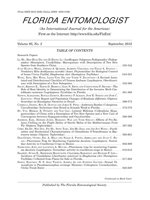Anastrepha Schiner is a genus of Tephritidae with the largest diversity of species in the Neotropical region, and it is an important pest group that impacts fruit production (Norrbom et al. 1999). Species of Anastrepha are pests of horticulture and responsible for quarantine restrictions on imports of fruits and vegetables in many countries (Aluja & Mangan 2008; Hennessey et al. 2009; Nicácio & Uchôa 2011). Anastrepha has 267 valid species (Zucchi 2007; Canal 2010; Norrbom & Korytkowski 2007, 2009, 2011, 2012; Uramoto & Zucchi 2010; Norrbom & Uchôa 2011) with 112 (42%) recorded for Brazil, representing the greatest diversity of species of this genus in the world (Zucchi 2008).
In Brazil, State of Espírito Santo has one of the largest fruit fly diversities in the country (Zucchi 2008). Surveys including fragments of Atlantic rainforest in the north of Espírito Santo increased the records of Anastrepha species from 23 (Martins et al. 2000) to 36, confirming the widespread occurrence of this group of insects and contributed to better knowledge of its diversity (Uramoto et al. 2008ab; Zucchi 2008; Uramoto & Zucchi 2010).
Fruit flies adults were captured in 288 sites in 74 municipalities with McPhail traps baited with 5% protein hydrolyzed from Jul 1993 through Jul 2010. All traps were installed on tree branches, around 2–6 m above the ground. Females of Anastrepha were identified at the Department of Genetics and Evolutionary Biology, University of São Paulo, Brazil. Voucher specimens were deposited in the collection of the Department of Entomology and Acarology, Escola Superior de Agriculture Luiz de Queiróz, University of São Paulo (ESALQ /USP).
Anastrepha daciformis Bezzi, Anastrepha dissimilis Stone, Anastrepha mixta Zucchi and Anastrepha parallela (Wiedemann) are new records for Espírito Santo. (Table 1).
One specimen of A. daciformis was captured in an area around mangrove vegetation with Eugenia uniflora L., Malpighia glabra L., Mangifera indica L., Mimusops commersonii (G. Don) Engl., Psidium guajava L., Syzygium malaccense (L.) Merr. & L.M. Perry and Terminalia catappa L. on its surroundings. Eugenia sp. and Psidium guajava were associated with A. daciformis in Argentina (Norrbom 1998), but its host is unknown in Brazil (Zucchi 2008).
One specimen of A. dissimilis was captured occasionally in a Carica papaya L. orchard in State of Espírito Santo. This species was also collected in orchards of Citrus reticulata Blanco × C. sinensis (L.) (‘Murcott’ tangor) (Silva et al. 2006) and Citrus sinensis Osbeck (Chiaradia et al. 2004). Nonetheless, this species presents low frequency of captures in traps and has no host related; however it has been reported in all Brazilian regions (Araújo et al. 2005; Zucchi 2008) and in Argentina, Colombia, Guyana, Haiti, Peru and Trinidad (Carrejo & Gonzales 1994; Norrbom 2004).
One specimen of A. mixta was collected in a Carica papaya orchard in the municipality of Linhares. This species up to now has been reported only in Brazil (Norrbom 2004) in the States of Mato Grosso and Amapá with no host determination (Uchôa-Fernandes et al. 2002; Trindade & Uchôa 2011).
Anastrepha parallela was captured occasionally in Carica papaya orchards. This species has been recorded as abundant in an Atlantic rainforest fragment at “Vale Natural Reserve” in Linhares, and on plants of the family Sterculiaceae (= Malvaceae) in State of Bahia (Nascimento & Carvalho 2000; Zucchi 2008), Pouteria caimito (Ruiz & Pav.) Radlk. (Sapotaceae) and Sterculia apetala (Jacq.) H. Karst. (Sterculiaceae = Malvaceae) in Colombia (Carrejo & Gonzales 1994).
The 4 new findings in our report extend from 36 to 40 the species of Anastrepha registered in the State of Espírito Santo, Brazil.
SUMMARY
Anastrepha Schiner is the genus of Tephritidae with the greatest diversity in the Neotropical region and the largest number of species in Brazil, and which imposes quarantine restrictions for imports of fruits and vegetables from countries in which it occurs. The objective of this paper is to present new records of Anastrepha species in State of Espírito Santo, Brazil. McPhail traps were used to capture adults in 74 municipalities. The occurrence of A. daciformis Bezzi, A. dissimilis Stone, A. mixta Zucchi and A. parallela (Wied.) are new records for the State of Espírito Santo.
TABLE 1.
FIRST RECORDS OF ANASTREPHA SPECIES CAPTURED IN THE STATE OF ESPÍRITO SANTO, BRAZIL, MUNICIPALITY OF COLLECTION (CITY), GEOGRAPHICAL COORDINATES (COORDINATES), NUMBER OF SPECIMENS COLLETED (NO. FEM.) AND BRAZILIAN REGIONS AND STATES WITH RECORDS OF SPECIES (REGIONS / STATES), JULY 1993 TO JULY 2010.

Key Words: Anastrepha daciformis, Anastrepha dissimilis, Anastrepha mixta, Anastrepha parallela, fruit flies
RESUMO
Anastrepha Schiner tem a maior diversidade do gênero de Tephritidae na região Neotropical e o maior número de espécies no Brasil. Espécies praga desse gênero são responsáveis por restriçõcirc;es quarentenárias à importação de frutas e vegetais para diversos países. O objetivo deste trabalho é apresentar novos registros de ocorrência de espécies de Anastrepha para o estado do Espírito Santo, Brasil. Armadilhas tipo McPhail foram utilizadas em 74 municípios. A ocorrência de A. daciformis Bezzi, A. dissimilis Stone, A. mixta Zucchi e A. parallela (Wied.) são novos registros para o Estado do Espírito Santo.
Palavras-chave: Anastrepha daciformis, Anastrepha dissimilis, Anastrepha mixta, Anastrepha parallela, moscas-das-frutas
ACKNOWLEDGMENTS
We express gratitude to Conselho Nacional de Desenvolvimento Científico e Tecnológico (CNPq), Fundação de Amparo a Pesquisa do Estado de Minas Gerais (FAPEMIG) and Fundação de Amparo a Pesquisa do Estado do Espírito Santo (FAPES) for financial support.





